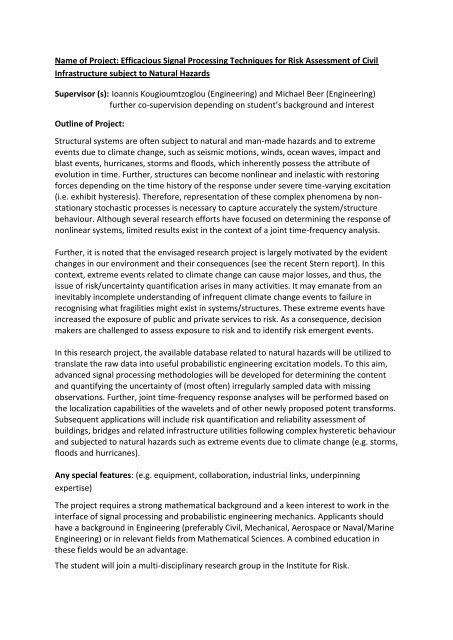Institute of Risk http://www.liv.ac.uk/risk-and-uncertainty PhD Project ...
Institute of Risk http://www.liv.ac.uk/risk-and-uncertainty PhD Project ...
Institute of Risk http://www.liv.ac.uk/risk-and-uncertainty PhD Project ...
Create successful ePaper yourself
Turn your PDF publications into a flip-book with our unique Google optimized e-Paper software.
Name <strong>of</strong> <strong>Project</strong>: Effic<strong>ac</strong>ious Signal Processing Techniques for <strong>Risk</strong> Assessment <strong>of</strong> Civil<br />
Infrastructure subject to Natural Hazards<br />
Supervisor (s): Ioannis Kougioumtzoglou (Engineering) <strong>and</strong> Michael Beer (Engineering)<br />
further co-supervision depending on student’s b<strong>ac</strong>kground <strong>and</strong> interest<br />
Outline <strong>of</strong> <strong>Project</strong>:<br />
Structural systems are <strong>of</strong>ten subject to natural <strong>and</strong> man-made hazards <strong>and</strong> to extreme<br />
events due to climate change, such as seismic motions, winds, ocean waves, imp<strong>ac</strong>t <strong>and</strong><br />
blast events, hurricanes, storms <strong>and</strong> floods, which inherently possess the attribute <strong>of</strong><br />
evolution in time. Further, structures can become nonlinear <strong>and</strong> inelastic with restoring<br />
forces depending on the time history <strong>of</strong> the response under severe time-varying excitation<br />
(i.e. exhibit hysteresis). Therefore, representation <strong>of</strong> these complex phenomena by nonstationary<br />
stochastic processes is necessary to capture <strong>ac</strong>curately the system/structure<br />
behaviour. Although several research efforts have focused on determining the response <strong>of</strong><br />
nonlinear systems, limited results exist in the context <strong>of</strong> a joint time-frequency analysis.<br />
Further, it is noted that the envisaged research project is largely motivated by the evident<br />
changes in our environment <strong>and</strong> their consequences (see the recent Stern report). In this<br />
context, extreme events related to climate change can cause major losses, <strong>and</strong> thus, the<br />
issue <strong>of</strong> <strong>risk</strong>/<strong>uncertainty</strong> quantification arises in many <strong>ac</strong>tivities. It may emanate from an<br />
inevitably incomplete underst<strong>and</strong>ing <strong>of</strong> infrequent climate change events to failure in<br />
recognising what fragilities might exist in systems/structures. These extreme events have<br />
increased the exposure <strong>of</strong> public <strong>and</strong> private services to <strong>risk</strong>. As a consequence, decision<br />
makers are challenged to assess exposure to <strong>risk</strong> <strong>and</strong> to identify <strong>risk</strong> emergent events.<br />
In this research project, the available database related to natural hazards will be utilized to<br />
translate the raw data into useful probabilistic engineering excitation models. To this aim,<br />
advanced signal processing methodologies will be developed for determining the content<br />
<strong>and</strong> quantifying the <strong>uncertainty</strong> <strong>of</strong> (most <strong>of</strong>ten) irregularly sampled data with missing<br />
observations. Further, joint time-frequency response analyses will be performed based on<br />
the localization capabilities <strong>of</strong> the wavelets <strong>and</strong> <strong>of</strong> other newly proposed potent transforms.<br />
Subsequent applications will include <strong>risk</strong> quantification <strong>and</strong> reliability assessment <strong>of</strong><br />
buildings, bridges <strong>and</strong> related infrastructure utilities following complex hysteretic behaviour<br />
<strong>and</strong> subjected to natural hazards such as extreme events due to climate change (e.g. storms,<br />
floods <strong>and</strong> hurricanes).<br />
Any special features: (e.g. equipment, collaboration, industrial links, underpinning<br />
expertise)<br />
The project requires a strong mathematical b<strong>ac</strong>kground <strong>and</strong> a keen interest to work in the<br />
interf<strong>ac</strong>e <strong>of</strong> signal processing <strong>and</strong> probabilistic engineering mechanics. Applicants should<br />
have a b<strong>ac</strong>kground in Engineering (preferably Civil, Mechanical, Aerosp<strong>ac</strong>e or Naval/Marine<br />
Engineering) or in relevant fields from Mathematical Sciences. A combined education in<br />
these fields would be an advantage.<br />
The student will join a multi-disciplinary research group in the <strong>Institute</strong> for <strong>Risk</strong>.

















